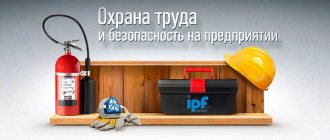The safety of the production process is achieved through compliance with the requirements of the labor protection law. The purpose of instruction is to train personnel to behave safely in the workplace. Instructions and types of training programs depend on the specifics of production and the equipment used.
Conducting on-the-job training.
What regulations govern
The main issues of safe operation of the enterprise are regulated by regulations at the federal and municipal levels.
Federal acts include:
- Constitution of the Russian Federation;
- Labor Code of the Russian Federation (section 10, articles 209 – 231);
- Federal Law of December 28, 2013 No. 426-FZ;
- Federal Law of July 24, 1998 No. 125-FZ;
- Federal Law of July 21, 1997 No. 116-FZ;
- GOST R 12.0.006.2002;
- industry and inter-industry agreements containing requirements on labor protection issues.
Acts at the municipal level are documents containing requirements regarding compliance with safety regulations in a separate municipality.
Types of briefings
GOST 12.0.004-2015 provides for 5 main types of briefings.
Introductory
This is the first interview that individuals accepted into this unit undergo. During the instruction process, safety rules are introduced.
Primary
The employee is instructed before starting work. Training is carried out in the place where he will work. Documents containing information about the operation of the equipment with which the employee will be associated are studied.
Repeated (periodic)
Everyone working in the organization undergoes this training periodically to update their knowledge. Various situations that lead to injury are analyzed.
Unscheduled
It is carried out:
- in case of violation of safety regulations;
- after breaks of 1 or 2 months (depending on the type of work);
- when new regulations are introduced;
- after making technical additions to the production maps.
Target
Such instruction is carried out:
- if necessary, perform work not related to the employee’s professional duties;
- after an emergency occurs;
- when to perform work with obtaining a permit;
- when visiting the enterprise by excursionists.
Existing types of TB training.
GENERAL REQUIREMENTS
1.1. Electrical safety group I applies to non-electrical personnel performing work that may pose a risk of electric shock. 1.2. Assignment of group I in electrical safety is carried out in the form of a briefing, which must end with a test of knowledge in the form of an oral survey and (if necessary) testing of acquired skills in safe ways of working or providing first aid in case of electric shock with registration in the Logbook for assignment of group I in electrical safety. 1.3. Assignment of group I is carried out by an employee from among the electrical technical personnel with a group not lower than III, appointed by order of the head of the organization. 1.4. Persons with electrical safety group I must have an understanding of the dangers of electric current, safety measures when working with electrical equipment, know and practically provide first aid in case of electrical injury. 1.5. Assignment of electrical safety group I is carried out at least once a year. 1.6. The immediate supervisor of a newly hired employee is obliged to organize training for assignment to group I. 1.7. If an employee has not completed Group I electrical safety training, he is suspended from independent work. (The employee is exempted only from independent work, and not from work in general.) 1.8. The list of positions and professions of employees requiring assignment to group I in electrical safety is approved by order of the enterprise. Such employees include personnel engaged in: - working with PCs, multimedia equipment and office equipment, etc.; — work in premises where there is electrical equipment; — cleaning of industrial premises of the enterprise. 1.9. Electrical installations pose a great danger to humans, and human senses cannot detect the presence of voltage on the equipment from a distance, since electric current is odorless, colorless and silent. 1.10. The inability of the human body to detect current before it begins to act leads to the fact that the worker does not realize the real danger and does not take protective measures in a timely manner. 1.11. The danger of electric shock is also characterized by the fact that the victim cannot provide assistance to himself, and if assistance is provided ineptly, the person providing assistance may also suffer. 1.12. Approximately half of accidents involving electric shock occur during the professional activities of the victims. According to some data, electrical injuries account for about 30% of the total number of all injuries at work and, as a rule, have serious consequences. In terms of the frequency of deaths, electrical injuries are 15-16 times higher than other types of injuries. 1.13. Non-electrical personnel must: - comply with internal labor regulations and the established work and rest schedule; - perform work included in the job responsibilities or assigned by the administration, provided that he is trained in the rules for the safe performance of this work; — apply safe work practices; - be able to provide first aid to victims. 1.14. An employee who violates or fails to comply with the requirements of this instruction is considered a violator of industrial discipline and may be subject to disciplinary liability, and depending on the consequences, to criminal liability; if the violation is associated with causing material damage, then the perpetrator may be held financially liable in the prescribed manner.
Fire safety briefing
The employee must know and strictly follow the provisions of the instructions on fire safety measures, and in the event of a fire danger, take all measures within his power to save property and extinguish the fire.
Federal Law No. 69-FZ of December 21, 1994 “On Fire Safety” (Articles 25 and 37) states that the employer is obliged to create conditions for training employees in fire safety. Persons who have not completed training are not allowed to work.
The learning objectives are:
- familiarization with the territory, evacuation routes, behavior in an emergency situation;
- obtaining an understanding of production activities, flammable materials and raw materials used;
- information about fire extinguishing means, smoke removal systems;
- studying the rules and sequence of actions in emergency situations.
An introductory interview, initial and repeated instructions on fire safety are carried out during general labor protection training.
Unscheduled briefing is carried out after:
- amendments to fire safety instructions;
- situations leading to fire hazard;
- liquidation of fire consequences.
Targeted instruction is carried out if necessary:
- perform actions of high fire danger;
- eliminate the consequences of a fire;
- obtain permission to carry out work.
Everything you need to know about fire safety instructions.
Measures to ensure electrical safety at work
A number of organizational and technical measures, compliance with equipment repair deadlines, compliance with tolerances, appointment of persons, work according to orders and orders, training of electrical installation workers, conducting electrical safety tests, all these components are measures to ensure electrical safety.
Basic safety measures used to reduce the level of electrical injuries at work:
- Grounding or grounding of electrical equipment elements. Grounded connections prevent current from flowing under normal operating conditions.
- Double insulation. The body of such a machine has an identification mark - a square within a square. Manual electric machines with this sign do not require grounding.
- Use of low-voltage lamps in production. According to generally accepted practice, in rooms with hazardous and especially hazardous working conditions, portable lamps should not have a voltage higher than 50 V, and if they are used in particularly unfavorable conditions, no higher than 12 V.
- Starting/shutdown of electrical equipment is permitted only to personnel with an electrical safety group of at least 3.
- Application of RCD. Protective devices are specially designed to automatically operate in the event of an insulation failure and an increase in the leakage current to certain values.
- Use of PPE. Insulating tools, dielectric gloves and boots, stands and other means.
Electrical safety briefing
An important component of production safety is compliance with electrical safety measures. This is facilitated by training in the principles of safe handling of electrical equipment.
The Order of the Ministry of Labor of the Russian Federation dated July 24, 2013 No. 328n “On approval of the Rules for labor protection during the operation of electrical installations” indicates which categories of workers are trained in electrical safety issues.
There are 2 groups of employees:
- using a computer, copy machine and other similar devices and devices;
- working with power tools and electrical installations.
Appendix 1 to the Order of the Ministry of Labor of the Russian Federation dated February 19, 2016 No. 74n contains a list of groups for which instruction is required.
An employee whose work will not involve special power tools undergoes training on the first day of work and is assigned group 1.
An employee who uses power tools undergoes training and an exam and will be assigned a Group 2 rating.
Re-instruction is carried out once every 3 or 6 months.
Unscheduled briefings are carried out when working conditions change, an emergency occurs, or the use of new equipment.
Electrical safety briefing for 1 qualification group.
How does electric current affect the human body?
There are three ways in which current can influence a living organism:
- The biological effect causes muscle contraction, convulsions, and in case of more serious lesions, respiratory failure (even stopping), blood circulation, as well as malfunctions of the nervous system. Severe electric shocks sometimes lead to death.
- Electrolytic effects are expressed in changes in the chemical composition of blood plasma and other organic fluids.
- Thermal effects, as the name suggests, are associated with severe forms of electric shock, namely burns. One of the most dangerous factors is an electric arc. Local damage to tissues and organs of the human body from its action can have serious consequences.
The final outcome of an electrical injury always depends on several factors:
- Current strength. The interval at which a person begins to feel tingling is in the range from 0.5 to 1.6 mA. A current strength of about 10 mA corresponds to trembling in the hands. Often, such contractions lead to pinching of the conductor and the inability to free itself from the action of the current. In this case, it is necessary to push the victim away from the current source with a current-insulating object, such as a stick. Unlike direct current, alternating current with a value of up to 200 mA can cause cardiac arrest due to fibrillation.
- Type of current. The permissible value of direct current, in contrast to alternating current, is 4 times higher at voltages up to 300V; its electrolytic effects cause danger.
- Body resistance. As you know, the human body is an electrical conductor. The main role is played by the potential difference that occurs during simultaneous contact of a wire that is energized with a conductor in the presence of a potential difference. The amount of resistance of the human body depends on several factors, but mostly on the size of the skin. If there is damage to the skin or moisture on it, its resistance drops. In addition, the higher the area of contact between the body and the conductor with current, the higher the likelihood of a breakthrough in the upper layer of skin.
- The duration of the current's effect on the body. A characteristic that directly affects the severity of electric shock. The explanations in this case are simple: the longer a person is exposed to current, the greater the negative consequences for the human body. Some marine life, such as eels, upon contact, are capable of producing dangerous discharges that cause loss of consciousness, but due to the short duration of the discharge (a few milliseconds), they do not cause serious negative consequences for the body. The duration of a current of 100 mA (lethal and dangerous value for humans) should not exceed half a second. Long-term exposure to current is harmful not only due to the duration of action, but also due to increased sweating at the points of contact. Moisture reduces resistance. To increase safety measures when working with electrical installations, residual current devices (RCDs) have been invented that allow you to turn off the current even with a short single-phase contact.
- Electric current path. When passing through the human body, current is especially dangerous when passing through the heart, brain or lungs. The most dangerous combination in case of electric shock is the path “right arm - legs” since it runs through the most important human organ - the heart, this is the main traumatic factor.
- Current frequency. The industrial frequency of current, adopted as a standard, and existing to this day in every home and industrial network, 50 Hz, poses a great danger because it causes ventricular fibrillation. The natural stimulation of repetitions is a frequency of 10 Hz, which is why the frequency of 50 Hz alternating current is so dangerous for the human body and its cardiac activity.
Occupational safety briefing for remote employees
There are companies where employees can work remotely. The head of the organization is obliged to familiarize such employees with safety provisions.
When signing an employment contract at the main office, a remote employee is given an introductory interview and then an initial briefing, after which he can begin working remotely.
Repeated training should take place at least once every 6 months. The event may be held using technical means that provide the possibility of communication.
Order of conduct
Compliance with the timing and sequence of briefings reduces the risk of accidents and emergencies. The first briefing is an introductory interview. Subsequent briefings are primary and periodic. Unscheduled and targeted are carried out by order.
Induction training is always carried out by a specialist from the department that carries out industrial safety measures. Instruction is carried out in a specially designated room.
The introductory briefing is carried out by a labor protection engineer.
The remaining instructions are carried out by the person responsible for production (manager).
Instructions carried out at the workplace are completed with an examination, during which the degree of readiness of the examinee for work is revealed. If the result is unsatisfactory, the preparation must be carried out again after some time.
The results are recorded in special journals and signed by all exam participants.
The results of passing the instruction exams are entered into a special journal.
Instruction program
A test to test knowledge of the rules of work in electrical installations of group ll on electrical safety
For briefings for the 1st group on electrical safety, a specially developed standard program is used. It takes into account all the topics the study of which will ensure occupational safety when using electrical receivers and equipment operating under voltage.
General requirements for electronic safety
This section explains in general terms what electrical safety is, what measures are taken to protect against electric shock, arc, electric field, stat. electricity. Instruct personnel on how to properly use electrical appliances and devices to prevent incorrect handling of them. They focus on the fact that faulty equipment and electrical wiring become sources of fire.
The company's rules and work schedules are also studied here. Trainees are introduced to the basic actions when providing first aid to an electric shock victim.
EB rules
This topic deals with issues affecting hazardous production factors: touching live parts, faulty grounding or insulation, sparking and fire. They emphasize how important it is to follow these safety rules:
- preliminary familiarization with the instructions for using the email. device;
- checking the serviceability of the plug and socket before connecting the device to the network;
- actions in the event of a sudden breakdown of a device or device under voltage;
- compliance with fire safety rules and the ability to use primary extinguishing agents.
Make sure the device is de-energized
Other issues may also be addressed, taking into account the specifics of the work of non-electrical personnel.
Important! The person being instructed must know that violation or failure to comply with the rules entails administrative liability.
EB requirements during operation
When instructing group 1 on electrical safety, they talk about the need to carry out the following actions:
- checking cables, wires, electrical devices for the absence of external damage;
- checking the integrity of switches, sockets, plugs;
- the need to ensure the availability of fire extinguishing equipment and personal protection against smoke;
- avoiding touching the email instruments with wet hands;
- preventing devices from falling and mechanical impact on them;
- danger of touching exposed or damaged live wires;
- the need to ensure that all wires and cables do not come into contact with oily, damp or hot surfaces;
- consequences of self-adjustment or repair of a faulty device.
The training explains the importance of following these rules in the workplace. Failure to do so may result in fire or electric shock.
The effect of current on the human body
This section is also important, as it helps to understand the degree of risk of death if basic safety rules are not followed. The nature of the current and the physiology of a living organism capable of passing electricity through itself are explained to personnel.
Possible source of electric shock
Every place where live equipment is located is considered dangerous to life. At the same time, not only current can affect a person, but also static electricity, arc and electric/magnetic field. The degree of damage can be different and depends on individual factors: parameters of the circuit itself, the environment, physiological processes in the body and the condition of the skin.
During the briefing, the nature of each electronic action is explained. current on a living organism:
- thermal - burns, heating to high temperatures of organs that are in the path of the current;
- el/lytic – causes the decomposition of liquids (including blood);
- mechanical – when heated, a pressure surge in blood vessels and tissues is provoked; under the influence of electrical/dynamic forces, involuntary muscle contraction occurs;
- biological - internal processes are disrupted, tissues are excited and irritated.
They also highlight the direct effect of current, when only muscle tissue gets in the way. Particular attention is paid to reflex excitation affecting the central nervous system, as a result of which many vital organs are seriously damaged.
For your information. When studying the effect of electricity on living organisms, one should be aware that it does not pass without a trace and is classified as a serious injury.
Classification of injuries
Even non-electrical personnel with the first group should be able to distinguish between injuries and electric shocks. They are classified into local, general and electric shock.
Local
These injuries include damage to certain parts of the body, as well as violations of the integrity of tissues caused by current or arc. They are divided into:
- integumentary burn;
- surface el. signs;
- skin metallization;
- mechanical damage;
- electroophthalmia (eye lesions).
The degree of injury depends on the strength of the current that the victim came into contact with.
Are common
In this case, the entire body is affected, which is manifested by convulsive muscle contractions. The degree of impact of an electric shock can vary:
- barely perceptible convulsive contraction;
- muscle contractions are accompanied by severe pain, but without loss of consciousness;
- there is loss of consciousness, but the heart and breathing continue to function;
- complete lack of consciousness, failure of respiratory and cardiac activity;
- cardiac arrest and lack of breathing.
Electric shock does not necessarily result in death unless cardiac arrest occurs. But serious disorders in the functionality of many organs can appear within a few hours or days.
Electroshock
Electric current overly irritates the body's nervous-reflex system. In this case, contractile muscle movements, acute pain and a surge in pressure are observed. These symptoms do not last long, and then the opposite reaction occurs: the pressure drops, the pulse quickens, breathing weakens, and the nervous system slows down.
The body can be in a state of shock for several minutes or days. The affected person then either gradually recovers or dies. It all depends on a combination of many factors, which are explained during the briefing.
Step voltage
The instructive training program on electrical safety for non-electrical personnel also addresses this issue. You need to know what electrical spreading is. current on the surface of the earth in order to take the necessary measures in time.
The correct actions of personnel are important, depending on their location and the location of the fault. During the instruction, they teach you how to move correctly in short steps, without taking your legs off each other. It explains why you should not jump out of the step voltage zone, and also indicates the mortal danger in case of a fall.
First aid
At this stage of the briefing, comprehensive measures to provide emergency assistance to a person who has received an email are described. injury. The importance of timeliness and the correct procedure for personnel is explained. The instructor teaches how to assess the condition of the victim, and also conducts practical classes in the technique of artificial respiration and chest compressions.
Training in artificial respiration techniques









